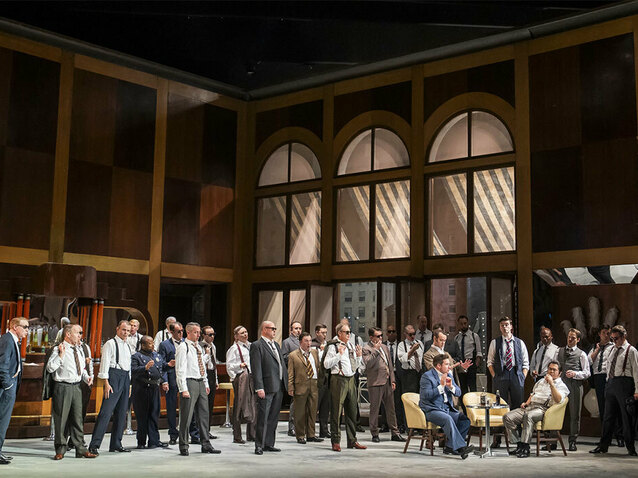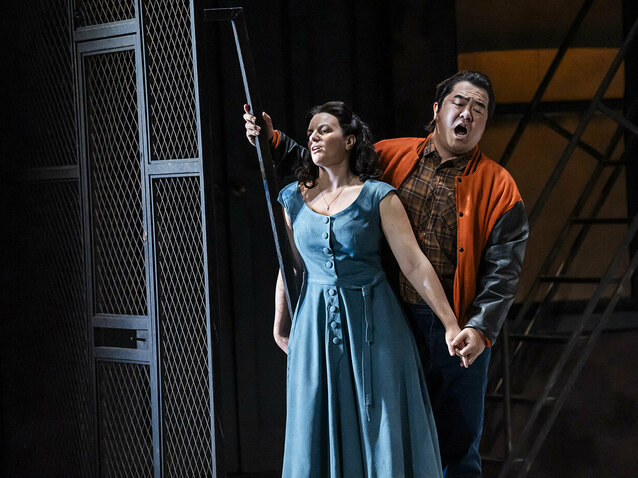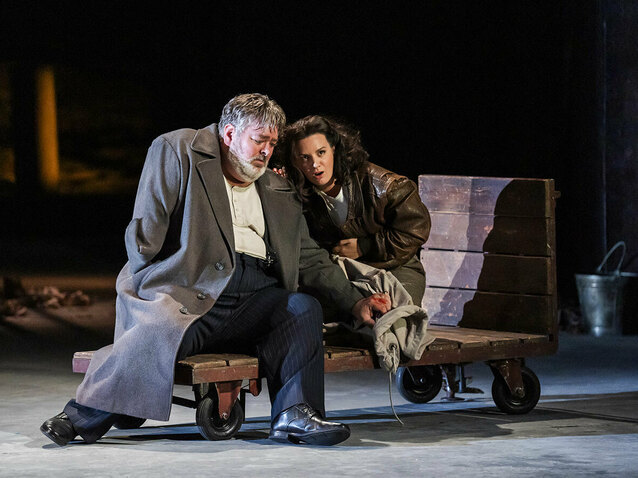 © Tristram Kenton
© Tristram Kenton
Based on Victor Hugo’s play Le roi s’amuse, Giuseppe Verdi’s Rigoletto was a triumph when it premiered at La Fenice in Venice in 1851, and has remained one of the composer’s most frequently performed operas ever since. Its popularity is thoroughly deserved but might still be deemed interesting, given that it is a contender for the cruellest opera in the mainstream repertoire. While many works see the innocent suffer and die, there is usually a sense in which virtue has triumphed, if only by remaining defiant in the face of evil. In the case of Rigoletto, however, it is a man who has been wronged by life as a whole, and a totally innocent young woman, who suffer the most dreadful of fates.
Originally set in the sixteenth century, and with a libretto by Francesco Maria Piave, the story revolves around the Duke of Mantua’s hedonistic lifestyle and womanising ways. In his employment is the jester and hunchback Rigoletto whose job it is to entertain everyone, especially the Duke. He goes about his task with a merciless zeal, so that the victims of his mockery become irate in the extreme. At the same time he is a loving father to his daughter Gilda, who he tries to keep entirely separate from his public life. The people do, however, learn of her existence, and the problem is compounded because Gilda has fallen in love with the Duke.
The latter’s infatuation with her is more temporary, but she has fallen so completely for him that when things come to a head she voluntarily puts herself in his place to ensure that she is killed instead of him. Thus Rigoletto, having conscripted the assassin Sparafucile to kill the Duke, is presented with a sack that he discovers contains his own daughter’s body.
It is possible to argue that Rigoletto is the master of his own downfall because he chose to pursue his unscrupulous public ways with a merciless zeal. Surely, however, the role of jester was imposed on him in the first place by a society that could never view a hunchback as anything other than a comic being. Having forced him to carve a niche in this profession to begin with, the great and the good then point the finger at him when they feel exposed, and it is he who suffers terribly while those who are really in control (in other words, the Duke) walk away unscathed.

Robyn Allegra Parton, Yongzhao Yu, ENO’s Rigoletto 2024 © Tristram Kenton
Jonathan Miller’s production for English National Opera, which is revived on this occasion by Elaine Tyler-Hall, premiered in 1982. While 2014 actually saw the introduction of a new version by Christopher Alden, Miller’s staging returned in 2017 in a season that celebrated the life and works of the man, who was sadly to die in 2019. It places the action in Little Italy, the part of New York that would have been under the control of the Mafia, in the 1950s. Although the relationships between the characters have to be adjusted to suit the change in surroundings, it is only by a little because the overall dynamics find a natural fit in this new world.
The Duke becomes the title of a Mafia boss. Rigoletto, now the barman at a hotel where the Mafia throws parties, is not necessarily in the direct employment of The Duke in the same way as a sixteenth century jester would be, but the nature of his subservience is similar and obvious. One can see how he has realised he needs to stay in with the Mafia, and, in the absence of looks, money or status, has had to nurture his wit. One can also picture how Mafia members could egg him on to entertain them when they feel like it, and then suddenly turn against him if they feel insulted.
The setting also enables certain points that feature in the original plot to carry even greater resonance. The Duke defiles Monterone’s daughter, and it feels highly believable that this is a punishment he might mete out for Monterone having betrayed the Mafia. He also makes advances to the wife of Ceprano yet, in spite of this, in Act II Ceprano takes a prominent role in revelling in the Duke’s deeds on the one hand and mercilessly mocking Rigoletto’s ill fortune on the other. This is highly revealing of how everyone recognises the Duke as the person they need to cosy up to as the real source of power, and how Rigoletto is someone they know they can simply use and abuse as they please.
Patrick Robertson and Rosemary Vercoe’s sets are highly atmospheric as the Ducal Palace in Mantua becomes a hotel, the alleys around Rigoletto’s apartment carry a film noirish quality and Sparafucile’s abode becomes a diner that looks just like Edward Hopper’s Nighthawks. There are also a host of excellent touches. The Duke walks over to a jukebox to ‘put on’ the iconic ‘La donna è mobile’, and when he has to give a fake name to Gilda he comes up with Gualtier Maldè because that was the name appearing on the music stands of the band in the hotel bar. Several things also ground the action at a very specific point in time, such as a poster advertising the film From Here to Eternity as a new release. Similarly, when we hear that Sparafucile’s fee for killing a man is eighty dollars, the fact that we can relate to the currency being used makes us realise just how cheap life is judged to be, even if that amount would have gone much further then.

Weston Hurt, Robyn Allegra Parton, ENO’s Rigoletto 2024 © Tristram Kenton
Richard Farnes’s conducting is meticulous, and his attention to detail elicits some highly beautiful playing from the English National Opera Orchestra. Overall, the sound feels quite expansive, which enables the output to possess a certain sense of monumentally but leads to ‘Sì! Vendetta, tremenda vendetta!’ feeling quite sedate when it can generate a real rush of excitement. The situation in that duet may be compounded by the way in which Weston Hurt assumes the title role. His fine baritone possesses many pleasing grains, but is not especially strong at projecting across the vast Coliseum auditorium, which does affect how commanding the central character feels across the evening. Nevertheless, his final scene in Act III with Gilda is suitably emotive, while in the latter role Robyn Allegra Parton makes an impressive ENO debut. Her soprano produces some notably clean and precise notes, with the care that she shows feeling very much in tune with Farnes’s style of conducting. The fact that she focuses so hard on the exact sound she is producing initially seems to act as a check on her ability to get inside the character. This difficulty is soon overcome, however, and in Act II, even as she sings of her shame, one can glimpse the delight that she still feels every time she thinks of The Duke.
Yongzhao Yu as The Duke possesses enormous presence and an immensely expansive tenor that, although occasionally feeling a little unfocused, delivers a tremendous performance of ‘Ella mi fu rapita!’. There is also excellent support from William Thomas as Sparafucile, Amy Holyland as Maddalena, David Kempster as Monterone and Sarah-Jane Lewis as Giovanna. Finally, the roles of Ceprano (Edwin Kaye), Borsa (Thomas Elwin) and Marullo (Patrick Alexander Keefe) feel a lot better delineated than in many productions, and that may be attributable both to the strength of the performers on this occasion and the production itself, which is undoubtedly an ENO classic.
The performance on opening night was dedicated to the memory of ENO regular Nicholas Folwell, who sadly died in April and who played Monterone in the 2017 revival of this production. He will be sorely missed, and the Nicholas Folwell Scholarship Appeal has been established in his honour.
By Sam Smith
Rigoletto | 30 October - 21 November 2024 | London Coliseum
the 01 of November, 2024 | Print
Comments